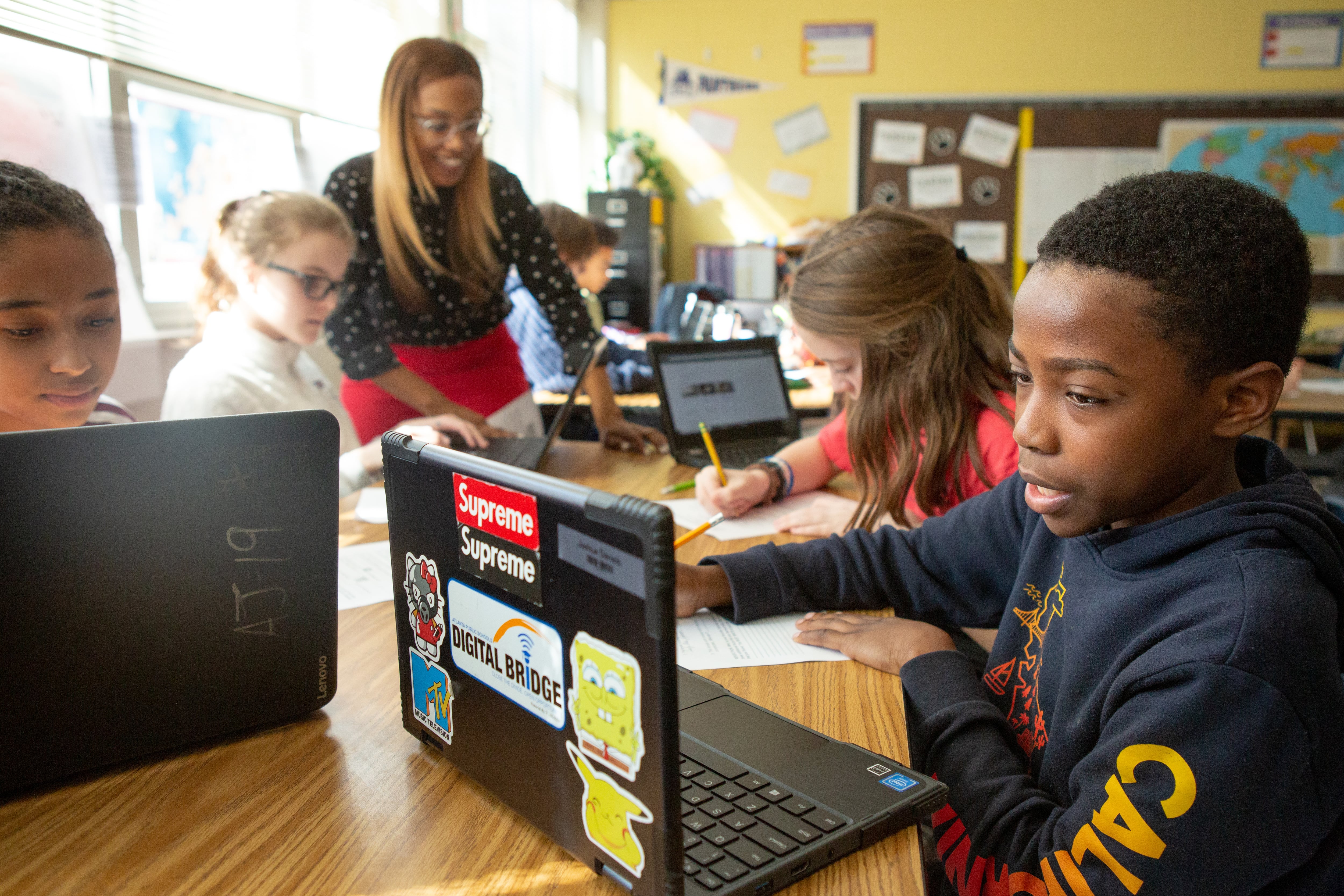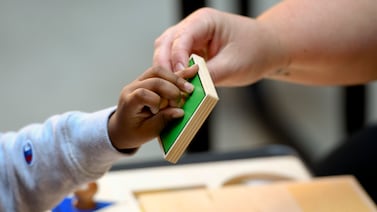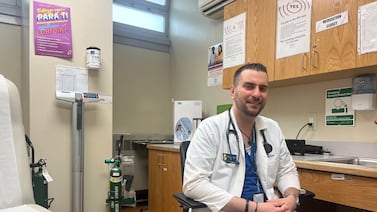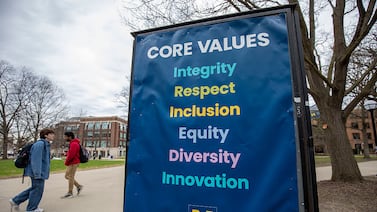Before the pandemic, U.S. history teacher Travis Malekpour hesitated assigning his students work in the classroom that required a computer. He knew not every student had a laptop or tablet.
Three years later, Malekpour, who teaches in Queens, doesn’t think twice about assigning and grading in-class work that requires a device.
After COVID shuttered campuses in March 2020, forcing schools to pivot to remote learning, the city spent more than $360 million to buy 725,000 iPads and Chromebooks. That seismic shift made devices more accessible to students than ever before — and has now pushed some teachers to fold technology more often into their lesson plans.
“Having students who now have tablets and laptops they bring to school definitely changes the game a little bit,” Malekpour said.
The city’s education department has embraced some virtual education models, including a hybrid high school program that mixes virtual instruction with in-person activities. They’ve also used federal relief dollars to fund virtual courses for students at small schools that can’t provide such classes. More recently, schools began using computer programs to prepare students for upcoming state English and math tests, angering some educators and families who want children to be interacting directly with instructors, Gothamist reported.
But there appears to be little official guidance from the department for schools navigating a post-remote learning world. A spokesperson said they encourage using “21st century teaching practices” and provide students with “personalized, flexible learning.”
Officials also offer professional learning for teachers on teaching in remote or hybrid environments.
Some students find reliance on technology frustrating
There is some evidence that older students prefer instruction that doesn’t lean on technology. Sixty-five percent of American teens ages 13-17 said they preferred returning to full in-person instruction after the pandemic, while 18% preferred a mix between in-person and online, according to a survey last year from Pew Research Centers.
Most of those surveyed didn’t seem to struggle profoundly when required to use technology: Of the 22% of teens who said they sometimes had to complete homework on their phones, just 1 in 5 said it made finishing assignments “a lot harder.”
But for some children, technology can make learning frustrating.
About half of Eva Lang’s classes at a Manhattan high school require using laptops daily. The 15-year-old said she finds it distracting when her classmates are playing video games instead of doing the assignment.
Submitting assignments online can be convenient, Eva said. However, when her teachers post homework to Google Classroom without first discussing it in class, she sometimes has to ask questions via email, which can go unanswered. Some teachers make online assignments due the night before the next class — meaning she can’t complete it on the way to school if she wanted to focus on more complicated homework the night before.
Other times, the due date is a Friday night.
“It’s never, like, a really long assignment, but you know Friday nights are when you’re done from school or [ready] for the weekend, and you don’t want to be worrying about homework,” Eva said.
Many parents, too, have expressed concerns about increased screen time during the pandemic. One 2021 study of more than 5,400 children, which looked at screen use during the pandemic, saw a link between more screen time and worsening mental health, including feelings of stress. U.S. Surgeon General Vivek Murthy noted in 2021 that while some studies have found that online platforms can lead to worsened mental health, there is not enough robust research to make a conclusion.
Some teachers find creative uses for technology
With more devices in students’ hands, Malekpour, the Queens teacher, feels comfortable asking them to complete online assignments for a grade while in class, such as answering a sample U.S. History Regents exam question using Google Form or typing up a short essay response to a prompt.
But if he’s teaching about political cartoons, he’d have them draw their own examples on paper.
Even before the pandemic, one Brooklyn science teacher knew of free, interactive lab activities available online that seemed useful when the school couldn’t afford materials for hands-on experiments, or for understanding more dangerous concepts, such as radioactivity.
But the teacher, who requested anonymity because she was not free to talk to the press, couldn’t always use those virtual labs because not all students had a laptop or a phone.
Now, for the first time in her two decades of teaching, she has a laptop cart in her classroom, meaning her students can do virtual labs in addition to hands-on experiments, she said. This week her students used a virtual lab to study different states of matter. With the click of a button, they could change matter from gas to liquid to solid by controlling the temperature.
“Before, you would just teach it,” she said. “This way, they find out for themselves — rather than just being told, they explore.”
Tom Liam Lynch, vice president of education at the United Way of NYC and a former education technology professor, said a “fundamental conversation” that needs to happen around the role of technology in schools must start with what high-quality instruction looks and feels like for students.
Frustrations like Eva’s, the Manhattan student, represent a situation where it might not be working well, Lynch said.
“In those moments [the teacher’s] focus is on getting an assignment up and getting into the classroom, and they’ve lost touch around the fundamental question of, ‘Why am I doing this in the first place? How is this going to make a child feel?’” he said.
For some teachers, remote learning didn’t impact how they teach now. Despite the education department’s investment in technology, there are still students who don’t have access to devices or the internet. The city is currently attempting to count up all devices that schools have in their possession.
Not every student has access to a laptop during the school day at the Bronx high school where Steve Swieciki teaches social studies. His use of computers in class has, in part, relied on whether he’s in a room with a laptop cart during that period.
When he does use computers, it’s for simpler work, such as reading a news article in class. He may toggle between having students read and discuss an excerpt from a textbook or providing that excerpt in Google Classroom and requiring students to answer questions about it as homework.
But that’s how he taught even before COVID.
He shared a recent example of how he lightly folds technology into a lesson: For an intro-to-law class, Swieciki recently had students use laptops to read two news articles about artificial intelligence. To pique their interest, he first had them read a New York Times story that detailed a conversation between a reporter and a Bing chatbot, who told the reporter it was in love with him — shocking and hooking the students to the topic.
Then, he had them pull up an Axios article about how lawmakers are seeking to regulate artificial intelligence.
Students spent the next class participating in a Socratic seminar, where they debated the role of government in regulating artificial intelligence.
The lesson went so well that Swieciki pivoted from what he had planned to teach in his following lesson.
“I’m actually putting off what I initially had planned for tomorrow and extending the discussion another day,” he said.
Reema Amin is a reporter covering New York City public schools. Contact Reema at ramin@chalkbeat.org.






